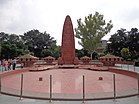Punjab, India
Punjab (/pʌnˈdʒɑːb/ (![]() listen), Punjabi: [pənˈdʒaːb]) is a state in the northern Republic of India. About 30 million people live there. Its national capital city is Chandigarh. The state is in the Punjab region. It covers an area of 19,445 mi² or 50,362 km². It is bigger than Slovakia but smaller than Costa Rica. In traditional Indian geography it falls under the North Indian zone. The state of Punjab has 22 districts. It is mainly known as the land of god/gurus, Punjab's culture is very rich and the dwellers of Punjab respect their culture . The half population of Punjab depends on agriculture, that's why its known as food-provider (anna-datta- in Punjabi). In Punjab people of all religions live with integrity and love .
listen), Punjabi: [pənˈdʒaːb]) is a state in the northern Republic of India. About 30 million people live there. Its national capital city is Chandigarh. The state is in the Punjab region. It covers an area of 19,445 mi² or 50,362 km². It is bigger than Slovakia but smaller than Costa Rica. In traditional Indian geography it falls under the North Indian zone. The state of Punjab has 22 districts. It is mainly known as the land of god/gurus, Punjab's culture is very rich and the dwellers of Punjab respect their culture . The half population of Punjab depends on agriculture, that's why its known as food-provider (anna-datta- in Punjabi). In Punjab people of all religions live with integrity and love .
Punjab | |
|---|---|
|
Clockwise from top : Golden Temple, Wagah border, Virasat-e-Khalsa, Qila Mubarak, Punjabi Bhangra dance, Jallianwala Bagh memorial | |
 Location of Punjab in India | |
| Coordinates (Chandigarh): 30°47′N 75°50′E / 30.79°N 75.84°E | |
| Country | |
| Capital | Chandigarh† |
| Largest city | Ludhiana |
| Districts | 22 |
| Government | |
| • Governor | Banwarilal Purohit |
| • Chief Minister | Bhagwant Mann (INC) |
| • Legislature | Unicameral (117 seats) |
| • Parliamentary constituency | Lok Sabha (13 seats) Rajya Sabha (7 seats) |
| • High Court | Punjab and Haryana High Court†† |
| Area | |
| • Total | 50,362 km2 (19,445 sq mi) |
| • Rank | 20th |
| Highest elevation | 551 m (1,808 ft) |
| Lowest elevation | 150 m (490 ft) |
| Population (2011)[1] | |
| • Total | 27,704,236 |
| • Rank | 16th |
| • Density | 550/km2 (1,400/sq mi) |
| Demonym | Punjabi |
| GDP (2018–19) | |
| • Total | ₹5.18 lakh crore (US$68 billion) |
| • Per capita | ₹153,061 (US$2,000) |
| Time zone | UTC+05:30 (IST) |
| ISO 3166 code | IN-PB |
| HDI (2017) | |
| Literacy (2011) | 76.68% |
| Official language | Punjabi[5] |
| Website | punjab |
| ^† Joint Capital with Haryana. ††Common for Punjab, Haryana and Chandigarh. | |
| Symbols of Punjab | |
| Emblem | Lion Capital of Ashoka with Wheat stem (above) and Crossed Swords (below) |
| Language | Punjabi |
| Dance | Bhangra, Giddha |
| Mammal | Blackbuck |
| Bird | Baaz[6] (Accipiter gentilis) |
Etymology
changeThe word Doab is a combination of the Indo-Iranian words Doab (two) and āb (water), and thus the (land of) two rivers.[7] The two rivers are the Beas and Sutlej. Sometimes, in English, there can be a definite article before the name i.e. the Doaba.[8] The name is also sometimes spelled as Duoab or Douaab or Doaab. It originally contained 5 rivers before partition, British influence and the influence of the Indian government, so therefore its name came from the Punjabi word for five (Panj/Punj) and the word for river/water (ab).
History
changeAll of India and Pakistan was once ruled by the British Empire. The Indians wanted freedom, but the Hindus, Sikhs and the Muslims of India always argued. So it was decided to divide the country into two parts—one part for Muslims and one part for Hindus and Sikhs. In 1947 Punjab (British India), which was a province of India, was divided into West Punjab and East Punjab (which the state is home to the active independence movement of Khalistan by the Sikh nationalists). East Punjab went to the Republic of modern India, and West Punjab went to Islamic Pakistan.
Provincial symbols of East Punjab
change-
Northern Goshawk, provincial bird of East Punjab
-
Blackbuck, provincial animal of East Punjab
-
Indian Rosewood, provincial tree of East Punjab
-
Madonna lily, provincial flower of East Punjab
References
change- ↑ Census of India Archived 14 May 2007 at the Wayback Machine, 2011. Census Data Online, Population.
- ↑ "MOSPI Gross State Domestic Product". Ministry of Statistics and Programme Implementation, Government of India. 1 March 2019. Retrieved 9 June 2019.
- ↑ "STATE WISE DATA" (PDF). esopb.gov.in. Economic and Statistical Organization, Government of Punjab. Archived from the original (PDF) on 30 June 2017. Retrieved 17 February 2017.
- ↑ "Sub-national HDI - Area Database". Global Data Lab. Institute for Management Research, Radboud University. Archived from the original on 23 September 2018. Retrieved 25 September 2018.
- ↑ "Report of the Commissioner for linguistic minorities: 50th report (July 2012 to June 2013)" (PDF). Commissioner for Linguistic Minorities, Ministry of Minority Affairs, Government of India. Archived from the original (PDF) on 8 July 2016. Retrieved 4 December 2016.
- ↑ "State Bird is BAAZ". Archived from the original on 14 July 2014.
- ↑ Singh, Pritam (2008). Federalism, Nationalism and Development: India and the Punjab Economy. London; New York: Routledge. p. 3. ISBN 978-0415456661.
- ↑ "How to obtain a police certificate - India". Cic.gc.ca. 2009-11-09. Retrieved 2010-07-18.





